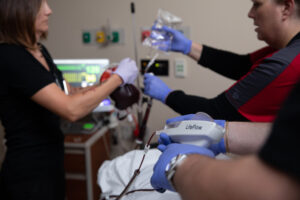
Acute gastrointestinal (GI) bleeding is a common cause of emergency department (ED) admissions– as many as 540,000 cases are admitted to the hospital each year in the United States.1 Of these cases, research indicates an average of 5.5%-8.8% result in mortality.2
The standard approach to managing unstable patients with active GI bleeding and hemorrhagic shock is rapid volume resuscitation via initiation of a mass transfusion protocol (MTP). Typically, these transfusions must be given using either IV pumps, pressure bags, or a bulky rapid infuser which requires time and familiarity to set up.
In contrast, LifeFlow can be set up in under two minutes with very little training and can deliver each unit of blood product in less than two minutes. The following case outlines the positive patient outcome when LifeFlow was included in the clinical strategy for treatment of hemorrhagic shock due to GI bleeding.
Case presentation
Our patient is a 49-year-old female who presents to the ED via emergency medical services (EMS). Prior to EMS transport, the patient was found unresponsive on the toilet at her home. She was noted to have had a bright red bloody bowel movement and emesis.
Her past medical history includes gastric bypass surgery, stomach ulcers, anal fissures, and GI bleeding which required an esophagogastroduodenoscopy (EGD) and colonoscopy to control bleeding.
Challenges
On the scene, paramedics reported her blood pressure (BP) to be in the 70s systolic. Peripheral intravenous (IV) access times two was established. The patient received 1 liter of normal saline (NS) in the field.
On arrival to the ED, her BP was 74/50, heart rate (HR) was 59, and her oxygen saturation was 97% on room air. She was alert and oriented times three, with a capillary refill greater than 2 seconds and very pale skin.
Initial lab work revealed a lactate of 1.1, red blood cell (RBC) count of 2.74, hemoglobin (Hgb) of 7.5, and hematocrit (Hct) of 24.
Management
The patient was diagnosed with hypovolemic and hemorrhagic shock. PRBC (packed red blood cell) transfusion was initiated using a LifeFlow device via peripheral IV access. Following the rapid administration of multiple units of PRBC’s with LifeFlow, the patient’s blood pressure improved to 96/63.
Additionally, a nasogastric tube was inserted and the patient was intubated for airway protection. The patient was also given three doses of epinephrine IV push, and a Levophed drip was initiated to maintain blood pressure. The patient was transferred to the ICU, where additional blood products were given.
A subsequent upper and lower GI scope was performed and indicated active GI bleeding and extensive clot burden. An arterial line and central line were placed in the ICU and the patient was further stabilized.
Discussion
Feedback from both ED and ICU nurses involved in the case was that, despite having limited prior LifeFlow experience, it was easy to set up and use in an emergency. The nurses stated that they felt LifeFlow was responsible for this patient’s ultimate survival. Because of this case and other positive outcomes during the trial phase of the device, this healthcare system is opting to fully integrate LifeFlow into their routine clinical practice.
Especially now, with ED nursing turnover so high and staff spread so thin, medical devices and procedures need to be not only effective, but also easy to use. Because LifeFlow is compact and portable, hospitals can stock LifeFlow throughout the ED, Labor & Delivery, and on the rapid response carts so that it’s readily available throughout the hospital for patients in need of urgent volume resuscitation.

